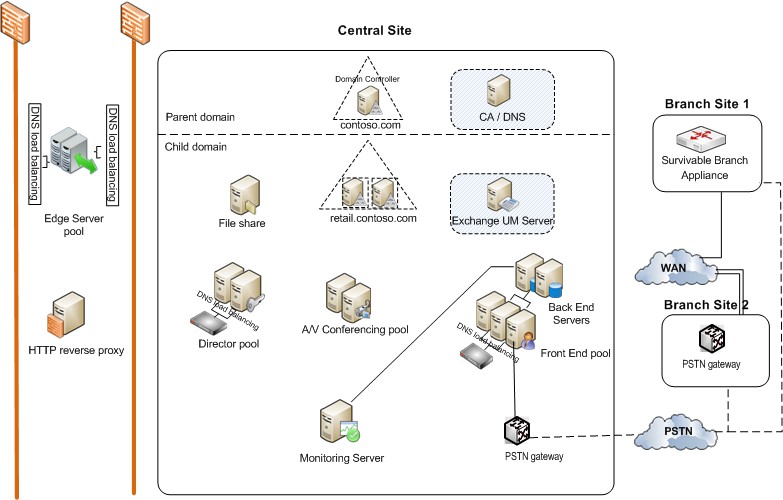Topic Last Modified: 2011-03-15
The reference topology with high availability and a single data center is designed for a small-to-medium size organization with one central site. The exact topology in the following diagram is for an organization of 15,000 users. Typically, the type of topology shown in the following diagram is recommended for organizations with 5,000 to 30,000 users, but it can support over 30,000 users.

- Active Directory deployment. All
Microsoft Lync Server 2010 communications software deployments
reside in a single Active Directory forest. For this topology, the
customer has Lync Server deployed in the child domain,
retail.contoso.com.
- Accommodate more users by adding more Front End
Servers. The exact topology in this diagram
has three Front End Servers, so it supports up to 20,000 users. If
you have a single central site and more users, you can simply add
Front End Servers to the pool. The maximum number of users per pool
is 80,000, with eight Front End Servers.
However, the single site topology can support even more users by adding another Front End pool to the site. To support these extra users, you need to add only one additional Front End pool (that is, just one pool each of A/V Conferencing Servers, Edge Servers, and Directors are sufficient, although more servers may need to be added to these pools).
- A/V Conferencing service can be collocated in smaller
organizations. If this organization has 10,000
or fewer users, you could decide to collocate the A/V Conferencing
service with the Front End pool, instead of deploying a separate
A/V Conferencing pool. For organizations with 10,000 or more users,
collocating these services is not recommended for performance
reasons.
- Monitoring Server database options. In
this topology, the Monitoring Server is using the same pair of
database servers that the Front End pool uses. A topology in which
the Monitoring Server has its own database servers is also
supported.
- High availability for all server
pools. In this example organization with
15,000 users, just one Director server, Edge Server and A/V
Conferencing Server would be sufficient for performance. However,
there are pools of two servers of each type deployed to provide
high availability for each feature.
- Branch site deployment options. The
organization in this topology has Enterprise Voice deployed as
their voice solution. Branch Site 1 does not have a resilient wide
area network (WAN) link to the central site, so it has a Survivable
Branch Appliance deployed to maintain many Lync Server features in
case the WAN link to the central site goes down. Branch Site 2
however has a resilient WAN link, so only a public switched
telephone network (PSTN) gateway is needed. The PSTN gateway
deployed there supports media bypass, so no Mediation Server is
needed at Branch Site 2. For details about deciding what to deploy
at a branch site, see Planning for Branch-Site
Voice Resiliency in the Planning documentation.
- DNS load balancing. The Front End pool,
Edge Server pool, and the Director pool have DNS load balancing for
SIP traffic deployed. This eliminates the need for hardware load
balancers for the Edge Servers, and significantly lessens the setup
and maintenance of the hardware load balancers for the other pools,
as the hardware load balancers are needed only for HTTP traffic.
For details about DNS load balancing, see DNS Load Balancing
in the Planning documentation.
- Exchange UM deployment. This reference topology includes
an Exchange Unified Messaging (UM) Server, which runs Microsoft
Exchange Server, not Lync Server. The Exchange UM routing
functionality for Lync Server runs on the Front End pool.
For details about Exchange UM, see On-Premises Exchange Unified Messaging Integration and Hosted Exchange Unified Messaging Integration in the Planning documentation.
- Edge Servers are recommended. Although
deploying an Edge Server is not required, we recommend it for any
size of deployment. You can maximize your Lync Server investment by
deploying an Edge Server to provide service to users currently
outside your organization’s firewalls. The benefits include the
following:
- Your organization’s own users can use Lync Server
functionality, if they are working from home or are out on the
road.
- Your users can invite outside users to participate in
meetings.
- If you have a partner, vendor or customer organization that
also uses Lync Server, you can form a federated relationship
with that organization. Your Lync Server deployment would then
recognize users from that federated organization, leading to better
collaboration.
- Your users can exchange instant messages with users of public
IM services, including any or all of the following: Windows Live,
AOL, and Yahoo! Note that a separate license might be required for
public IM connectivity with Windows Live, AOL, and Yahoo!
If you also deploy the Lync Server XMPP Gateway, you can enable your users to exchange instant messages with the users of providers and servers that use Extensible Messaging and Presence Protocol (XMPP), such as Google Talk and Jabber.
 Note:
Note:To use XMPP, you must install the XMPP Gateway. You can download the XMPP Gateway from the Microsoft Download Center at http://go.microsoft.com/fwlink/?LinkId=204552. After you install the XMPP Gateway, you need to install the hotfix, which is available for download from http://go.microsoft.com/fwlink/?LinkId=204561.
- Your organization’s own users can use Lync Server
functionality, if they are working from home or are out on the
road.

